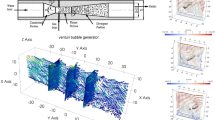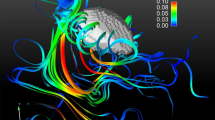Abstract
A recent technique of simultaneous particle image velocimetry (PIV) and pulsed shadow technique (PST) measurements, using only one black and white CCD camera, is successfully applied to the study of slug flow. The experimental facility and the operating principle are described. The technique is applied to study the liquid flow pattern around individual Taylor bubbles rising in an aqueous solution of glycerol with a dynamic viscosity of 113×10−3 Pa s. With this technique the optical perturbations found in PIV measurements at the bubble interface are completely solved in the nose and in annular liquid film regions as well as in the rear of the bubble for cases in which the bottom is flat. However, for Taylor bubbles with concave oblate bottoms, some optical distortions appear and are discussed. The measurements achieved a spatial resolution of 0.0022 tube diameters. The results reported show high precision and are in agreement with theoretical and experimental published data.
















Similar content being viewed by others
Abbreviations
- D :
-
internal column diameter (m)
- g :
-
acceleration due to gravity (m s−2)
- l w :
-
wake length (m)
- Q v :
-
liquid volumetric flow rate (m3 s−1)
- r :
-
radial position (m)
- r *:
-
radial position of the wake boundary (m)
- R :
-
internal column radius (m)
- U s :
-
Taylor bubble velocity (m s−1)
- u z :
-
axial component of the velocity (m s−1)
- u r :
-
radial component of the velocity (m s−1)
- z :
-
distance from the Taylor bubble nose (m)
- Z *:
-
distance from the Taylor bubble nose for which the annular liquid film stabilizes (m)
- Re :
-
Reynolds number (\( = \frac{{\rho U_{s} D}} {\mu } \))
- N f :
-
inverse viscosity number (\( = \frac{{g^{{1/2}} D^{{3/2}} \rho }} {\mu } \))
- δ :
-
liquid film thickness (m)
- ν :
-
liquid kinematic viscosity (m2 s−1)
- μ :
-
liquid dynamic viscosity (Pa s)
- ρ :
-
liquid density (kg m−3)
References
Adrian RJ (1991) Particle-imaging techniques for experimental fluid dynamics. Ann Rev Fluid Mech 23:262–304
Brown RAS (1965) The mechanism of large bubbles in tubes. 1. Bubble velocities in stagnant bubbles. Can J Chem Eng 43:217–223
Bugg JD, Saad GA (2002) The velocity field around a Taylor bubble rising in a stagnant viscous fluid: numerical and experimental results. Int J Multiphase Flow 28:791–803
Campos JBLM, Guedes de Carvalho JRF (1988) An experimental study of the wake of gas slugs rising in liquids. J Fluid Mech 196:27–37
Dias I, Riethmuller ML (2000) PIV in two-phase flows: simultaneous bubble sizing and liquid velocity measurements. In: Selected papers of the 9th symposium on laser techniques applied to fluid dynamics. Springer, Berlin Heidelberg New York, pp 71–85
Gouriet JB, Stitou A, Riethmuller ML (2001) Practical implications of camera resolution and peak locking in actual measurements. In: Proc 4th international symposium on particle image velocimetry, Gottingen, Germany, 17–19 September 2001
Gui L, Merzkirch W (1996) Phase-separation of PIV measurements in two-phase flow by applying a digital mask technique. ERCOFTAC Bull 30:45–48
Keane RD, Adrian RJ (1990) Optimisation of particle image velocimeter. 1. Double pulsed systems. Meas Sci Technol 1:1202–1213
Lindken R, Merzkirch W (2002) A novel PIV technique for measurements in multi-phase flows and its application to two-phase bubbly flows. Exp Fluids 33:814–825
Lindken R, Gui L, Merzkirch W (1999) Velocity measurements in multiphase flow by means of particle image velocimetry. Chem Eng Tech 22:202–206
Moissis R, Griffith P (1962) Entrance effects in a two-phase slug flow. J Heat Trans 84:29–39
Philip OG, Schmidl WD, Hassan YA (1994) Development of a high speed particle image velocimetry technique using fluorescent tracers to study steam bubble collapse. Nuclear Eng Des 149:375–385
Polonsky S, Barnea D, Shemer L (1999a) Average and time-dependent characteristics of the motion of an elongated bubble in vertical pipe. Int J Multiphase Flow 25:795–812
Polonsky S, Shemer L, Barnea D (1999b) The relation between the Taylor bubble motion and the velocity field ahead of it. Int J Multiphase Flow 25:957–975
Scarano F, Riethmuller ML (1999) Iterative multigrid approach in PIV image processing with discrete window offset. Exp Fluids 26:513–523
Sridhar G, Katz J (1995) Drag and lift forces on microscopic bubbles entrained by a vortex. Phys Fluids 7:389–399
Tokuhiro A, Maekawa M, Iizuda K, Hishida K, Maeda M (1998) Turbulent flow past a bubble and an ellipsoid using shadow-image and PIV techniques. Int J Multiphase Flow 24:1383–1406
van Hout R, Gulitsky A, Barnea D, Shemer L (2002) Experimental investigation of the velocity field induced by a Taylor bubble rising in stagnant water. Int J Multiphase Flow 29:579–596
Acknowledgements
The partial support of the Fundação para a Ciência e Tecnologia—Portugal through project POCTI/EQU/33761/1999 and scholarship BD/20301/99 is gratefully acknowledged. POCTI (FEDER) also supported this work via CEFT.
Author information
Authors and Affiliations
Corresponding author
Rights and permissions
About this article
Cite this article
Nogueira, S., Sousa, R.G., Pinto, A.M.F.R. et al. Simultaneous PIV and pulsed shadow technique in slug flow: a solution for optical problems. Exp Fluids 35, 598–609 (2003). https://doi.org/10.1007/s00348-003-0708-8
Received:
Accepted:
Published:
Issue Date:
DOI: https://doi.org/10.1007/s00348-003-0708-8




